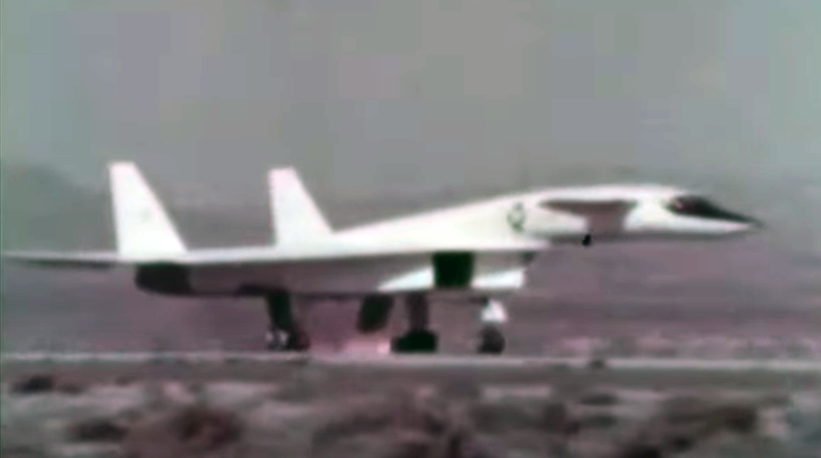The maiden flight of the XB-70A ended with tire blowout and fire.
With a planned cruise speed of Mach 3 and operational altitude of 70,000 feet, the B-70 Valkyrie was slated to be the ultimate American high-altitude, high-speed, deep-penetration manned strategic bomber.
Two XB-70A prototypes of the 6-engine aircraft were built by North American Aviation before the Kennedy Administration axed the program as a consequence of the doubts that surrounded the future of manned bombers: XB-70’s near-invulnerability was put in doubt when the first Soviet SAM (Surface to Air Missiles) were introduced in the late 1950s. Moreover, many considered the heavy bombers obsolete because they believed future wars would be fought with ballistic missiles only.
On Sept. 21, 1964, XB-70A number 1 (62-001) made its first flight from Palmdale to Edwards Air Force Base, CA. During its maiden flight test, one engine had to be shut down shortly after take-off, and an undercarriage malfunction warning forced the aircrew to fly with the undercarriage down as a precaution, limiting speed to 390 mph – about half that planned.
As shown in the video below, made by North American, during landing, the main landing gear wheels on the port side main gear locked and the giant Valkyrie suffered a tire blowout and fire, which you can see at 2:00 mark. According to PeriscopeFilm, that uploaded the footage to Youtube, another flight shown concluding at 3:35 is likely one of the first supersonic flights for the aircraft, as paint loss is clearly visible at 3:50 as the pilots deplane.
Similar incidents occur every now and then. Indeed, an aircraft braking system works by converting the kinetic energy of a moving aircraft into heat. The heat is generated by friction between the rotating and the stationary components of the brake assemblies (as well as the friction of tyres on the runway surface): if the heat becomes excessive, a fire in the braking assembly or tyres may occur. Should a fire develop because of “hot” brakes, cooling is usually obtained by responders using water or foam or halon cannons.
On Apr. 30, 1966, the second XB-70 prototype, the Air Vehicle 2 (AV 2), suffered a short-circuit in the landing gear retraction system shortly after the take-off from Edwards Air Force Base. As a result of this malfunction the nose gear was blown back into the partially retracted gear well door and the tires were slashed. The malfunction caused hydraulic pressure to remain on three of the four main wheel brakes which, being locked when the XB-70 landed at 173 knots hours later, led to the burn up of the Valkyrie main landing gear tires.
As explained in detail in a previous article on the XB-70 (that you can read here):
A joint agreement signed between NASA and the Air Force planned to use the second XB-70A prototype for high-speed research flights in support of the American supersonic transport (SST) program. However, on June 8, 1966, one of the most famous and tragic accidents in military aviation occurred. The second XB-70 collided with a civilian registered F-104N while flying in formation as part of a General Electric company publicity photo shoot over Barstow, California, outside the Edwards Air Force Base test range in the Mojave Desert. The aircraft were flying in formation with a T-38 Talon, an F-4B Phantom II, and a YF-5A Freedom Fighter.
Towards the end of the photo shooting NASA registered F-104N Starfighter, piloted by famous test pilot Joe Walker, got too close to the right wing of the XB-70, collided, sheared off the twin vertical stabilizers of the big XB-70 and exploded as it cartwheeled behind the Valkyrie. North American test pilot Al White ejected from the XB-70 in his escape capsule, but received serious injuries in the process. Co-pilot Maj. Carl Cross, who was making his first flight in the XB-70, was unable to eject and died in the crash.
[…]
Although research activities continued with the first XB-70, with a first NASA flight on April 25, 1967, the last one was on Feb. 4, 1969, the incident contributed to the demise of the ambitious XB-70 program.
The first NASA XB-70 flight occurred on April 25, 1967, the last one was on Feb. 4, 1969 when the aircraft made a subsonic structural dynamics test and ferry flight from Edwards AFB to Wright-Patterson Air Force Base, OH, where the aircraft was put on display at the Air Force Museum after 83 test flights and 160 hours and 16 minutes, flight time. Indeed, despite research activity helped measuring its “structural response to turbulence; determine the aircraft’s handling qualities during landings; and investigate boundary layer noise, inlet performance, and structural dynamics, including fuselage bending and canard flight loads”, time had run out for the research program. NASA had reached an agreement with the Air Force to fly research missions with a pair of YF-12As and a “YF-12C,” which was actually an SR-71, that represented a far more advanced technology than that of the XB-70. Indeed, in all, the two XB-70Bs logged 1 hour and 48 minutes of Mach 3 flight time during their career, whilst a YF-12 could log this much Mach 3 time in a single flight.
Although the XB-70 program was cancelled, data collected during the Valkyrie test flights were used in other programs, including the B-1 bomber and the Soviet Tupolev Tu-144 SST program (via espionage).









